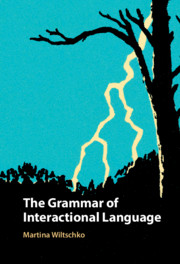Book contents
- The Grammar of Interactional Language
- The Grammar of Interactional Language
- Copyright page
- Dedication
- Contents
- Figures
- Tables
- Conversation Boards
- Acknowledgments
- Abbreviations
- Prologue
- 1 Interactional Language
- 2 The Syntacticization of Speech Acts
- 3 From Speech Acts to Interaction
- 4 The Interactional Spine Hypothesis
- 5 Initiating Moves: A Case-Study of Confirmationals
- 6 Reacting Moves: A Case-Study of Response Markers
- 7 The Grammar of Interactional Language
- Epilogue
- Bibliography
- Index
3 - From Speech Acts to Interaction
Published online by Cambridge University Press: 28 May 2021
- The Grammar of Interactional Language
- The Grammar of Interactional Language
- Copyright page
- Dedication
- Contents
- Figures
- Tables
- Conversation Boards
- Acknowledgments
- Abbreviations
- Prologue
- 1 Interactional Language
- 2 The Syntacticization of Speech Acts
- 3 From Speech Acts to Interaction
- 4 The Interactional Spine Hypothesis
- 5 Initiating Moves: A Case-Study of Confirmationals
- 6 Reacting Moves: A Case-Study of Response Markers
- 7 The Grammar of Interactional Language
- Epilogue
- Bibliography
- Index
Summary
Chapter 3 provides a review of current frameworks intended to understand interactional language. It serves as the basis to develop a grammar of interactional language Classic speech act theory, and current attempts to syntacticize it, do not take into consideration the interactional dimension, specifically the role of the addressee in constructing common ground. This chapter reviews several frameworks that take the interactional dimension into consideration. Specifically, I review dialogue-based models (conversation analysis and grounding theory), several functional grammar-based models, as well as recent formal semantic and syntactic approaches toward interactional language. The core lessons learned from these frameworks are that the unit of analysis of interactional language is a minimal conversation consisting of an initiating and a reaction move and that the construction of common ground is an interactive process. It further implies that we have to rethink the classic distinction between competence and performance. Itshows that what these frameworks are missing is a way to disentangle the various factors that contribute to the interpretation of discourse markers. Consequently, it becomes impossible to develop a typology. In contrast, formal syntactic approaches, while well equipped for cross-linguistic comparison, have not explored interactional language and consequently they lack the empirical base necessary to develop a typology. This chapter is the first attempt to survey these frameworks
Keywords
- Type
- Chapter
- Information
- The Grammar of Interactional Language , pp. 38 - 71Publisher: Cambridge University PressPrint publication year: 2021



